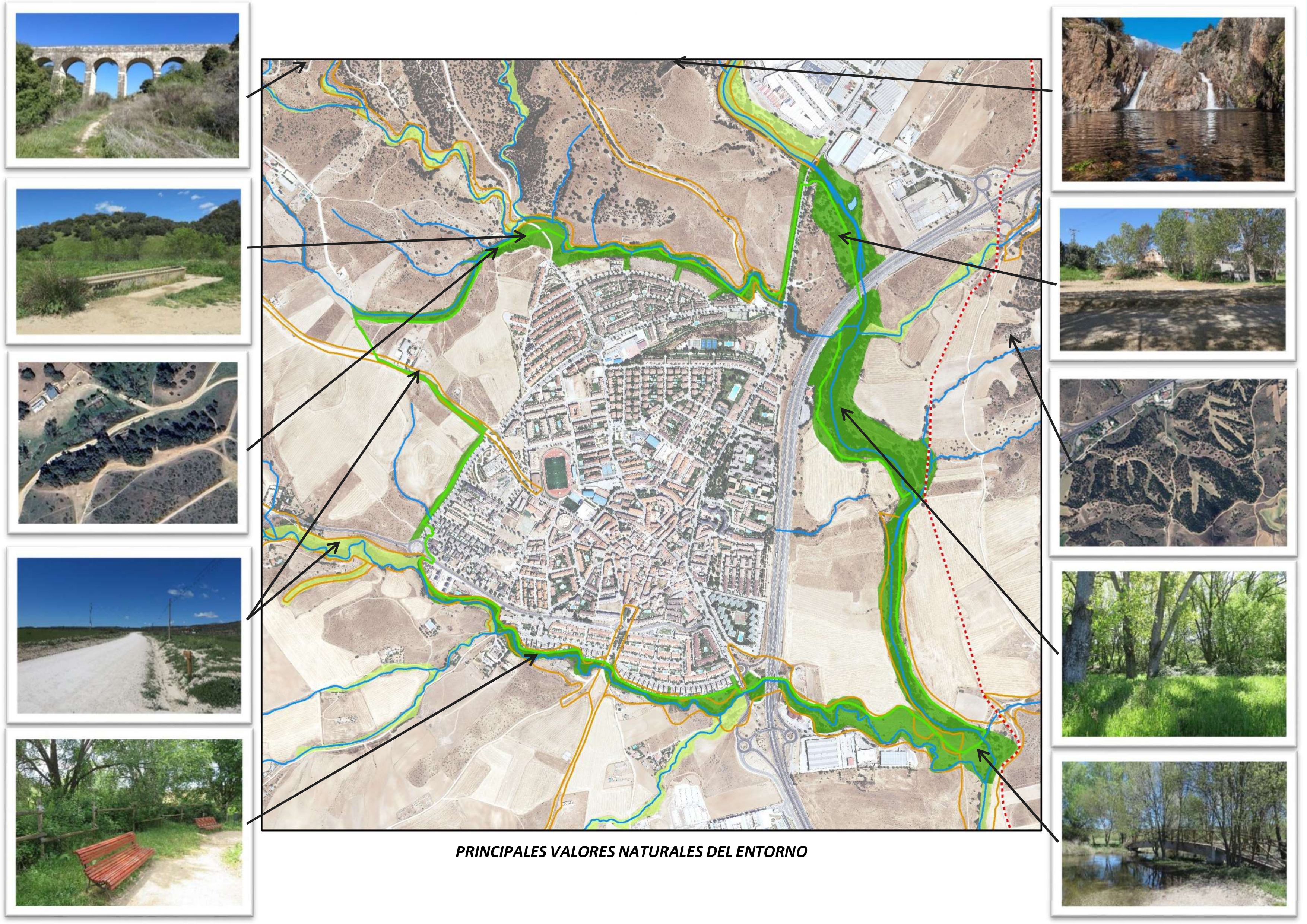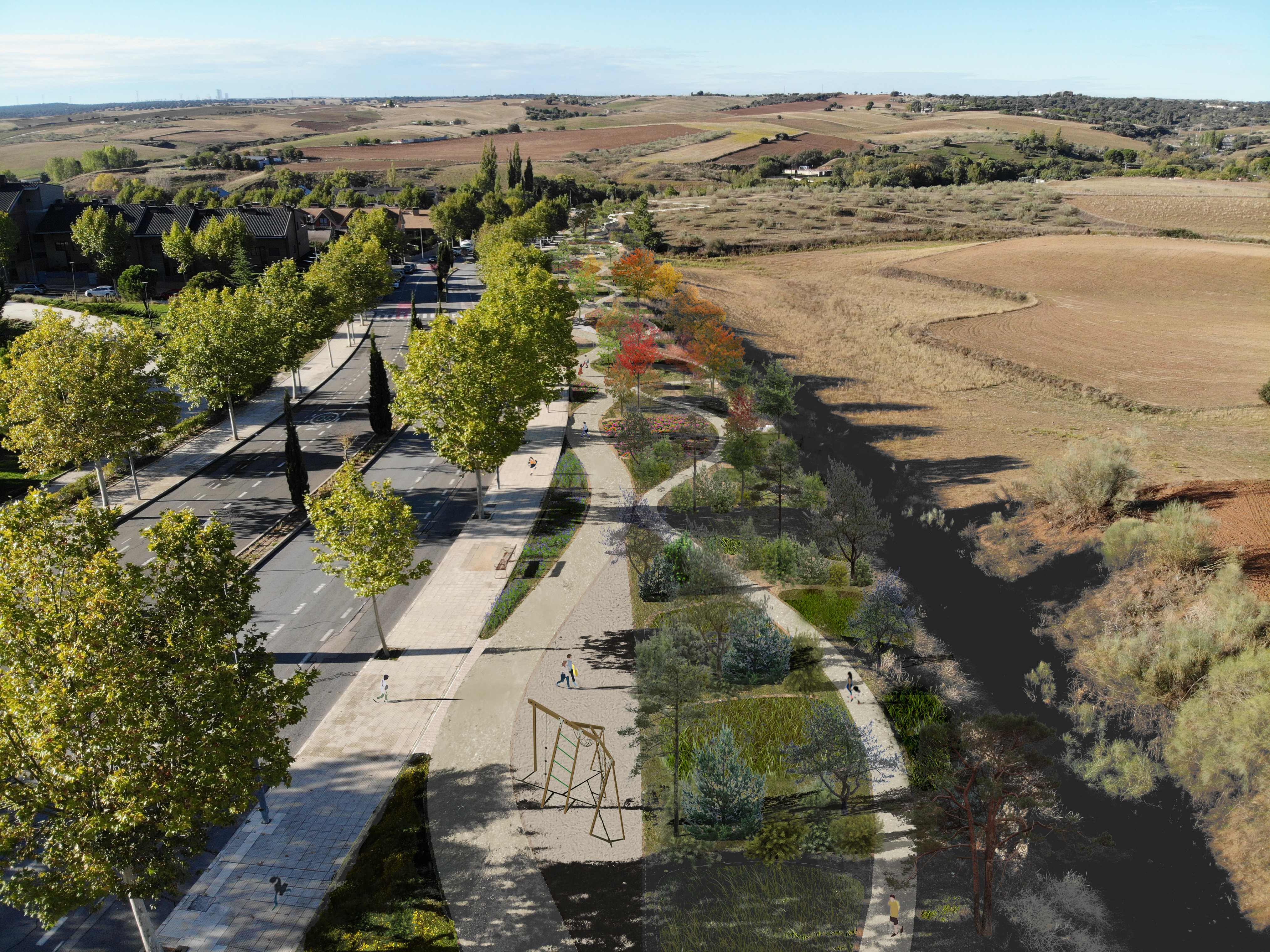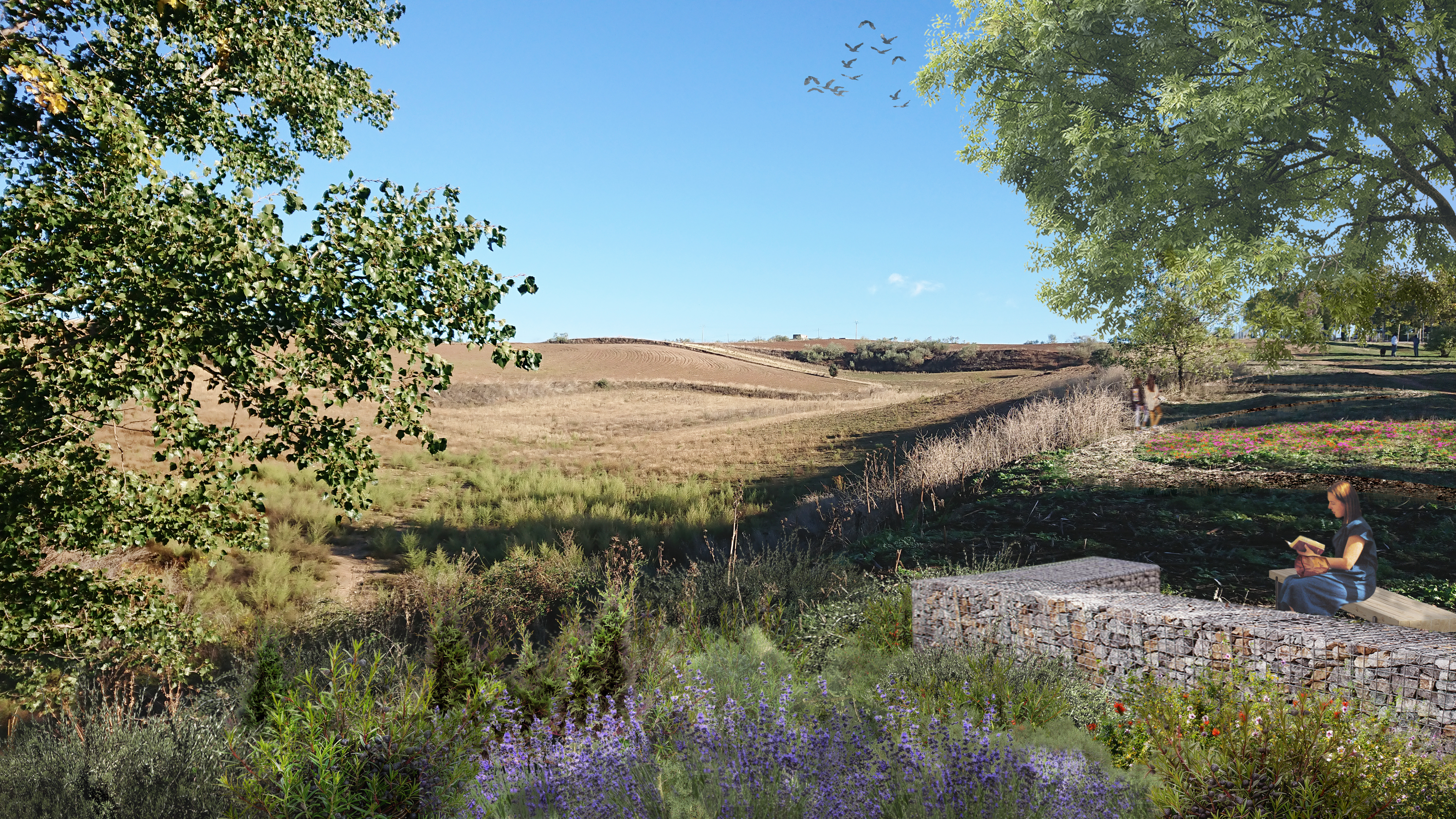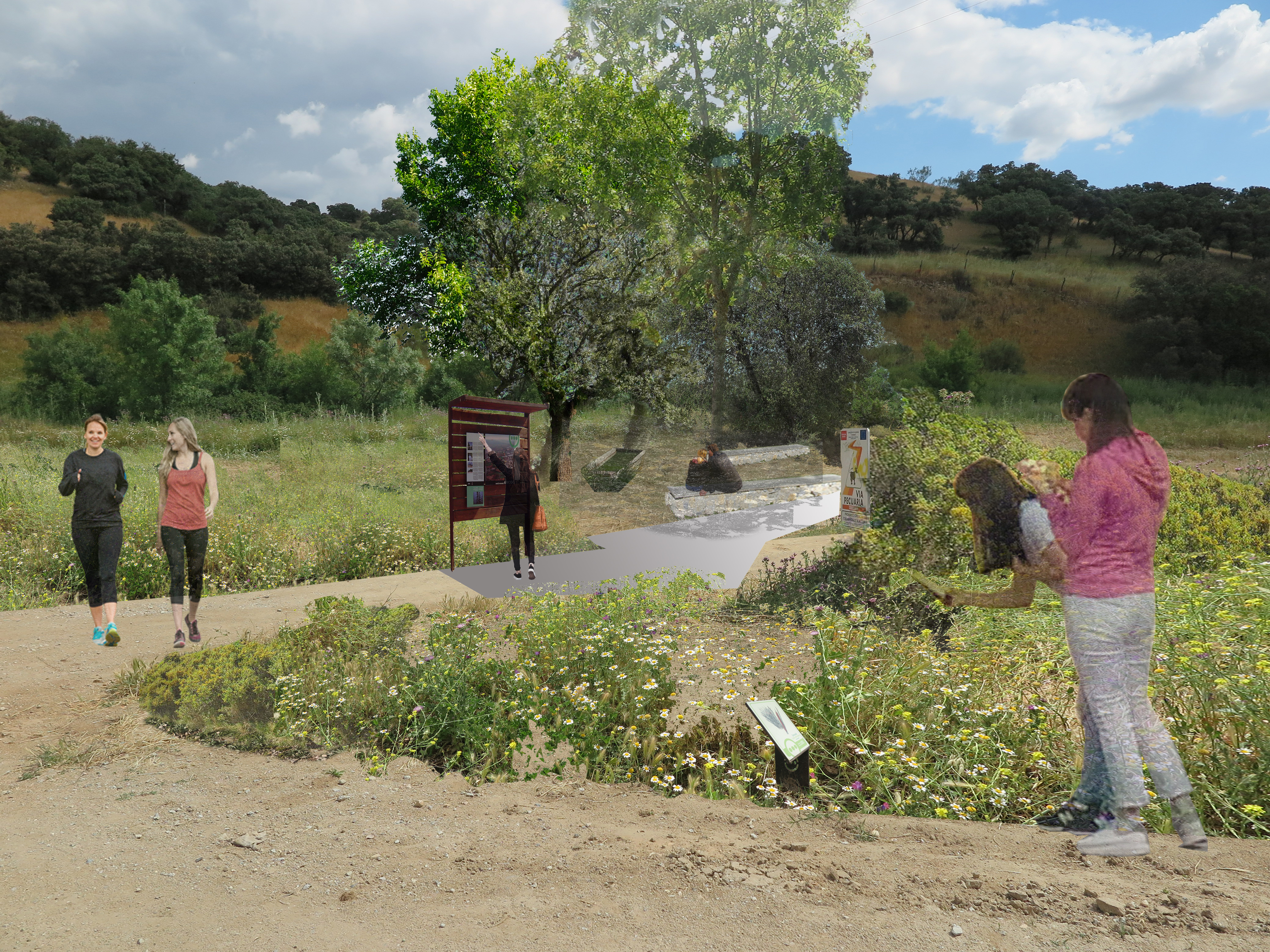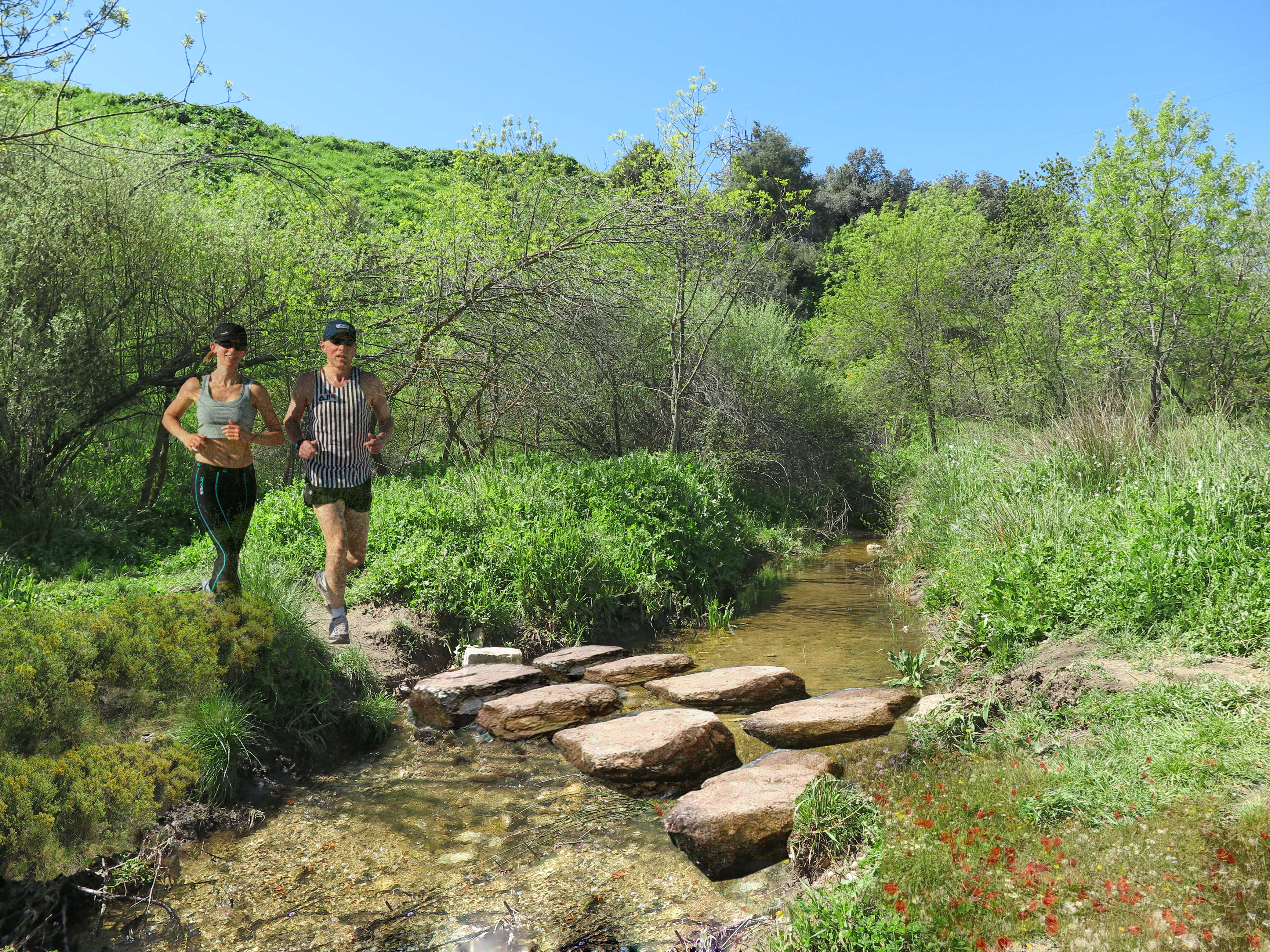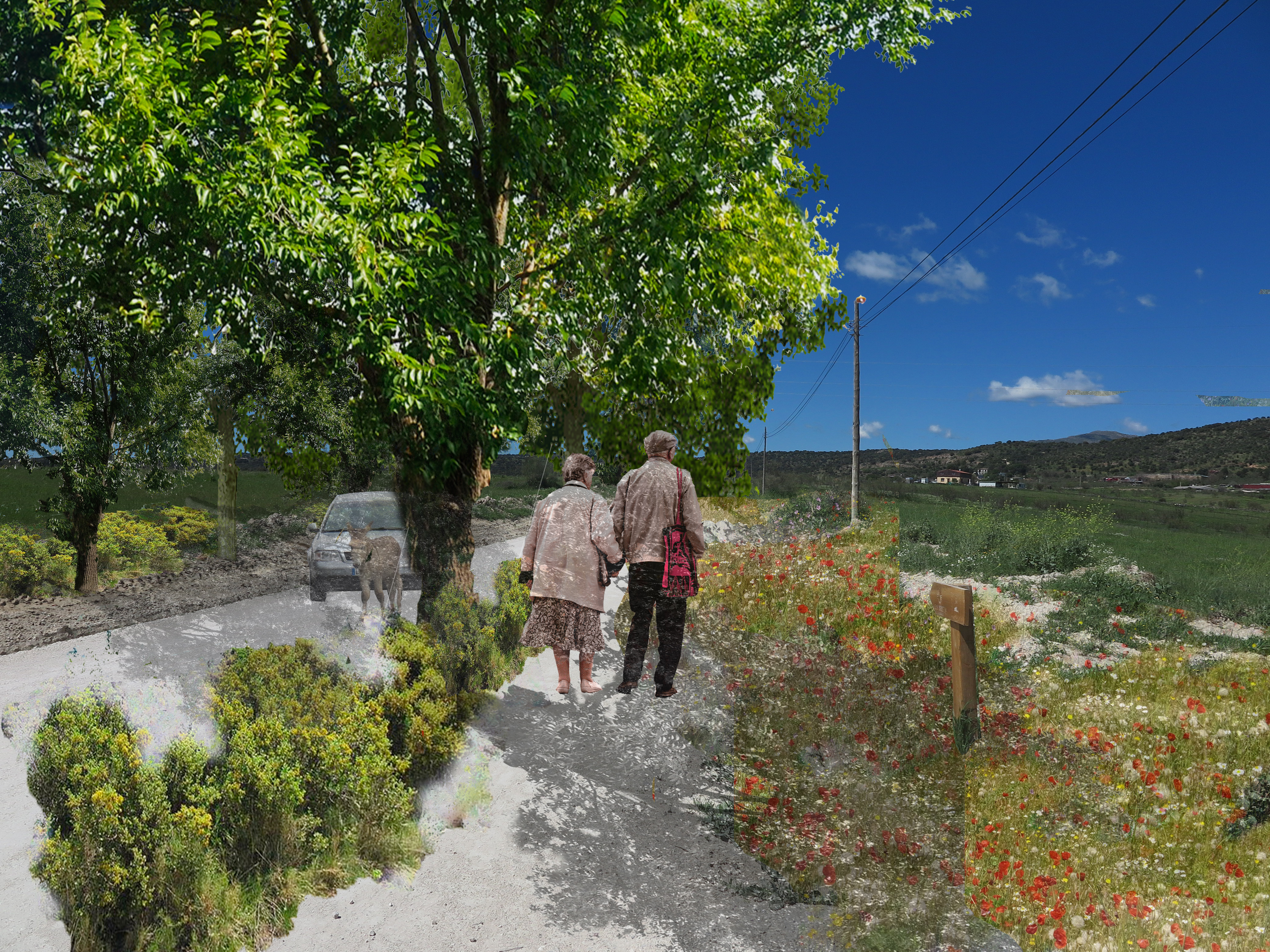RUTA NATURAL 360˚ SAN AGUSTÍN DEL GUADAL
“RUTA NATURAL 360˚ SAN AGUSTÍN DEL GUADALIX. DEVELOPING THE PERI-URBAN GREEN INFRASTRUCTURE.”
Ruta Natural 360º is a transformative initiative that links San Agustín de Guadalix through ecological corridors and urban spaces. By integrating nature-based solutions, this route minimizes the urban heat island effect, enhances biodiversity, restores neglected areas, and improves local sites. It provides a healthier and more inviting environment so that residents and visitors can walk, run or cycle, which is fully aligned with the NEB vision of sustainability, inclusion, and beauty
Spain
The initiative spans multiple peri-urban and natural areas within the municipality. The main urban center of San Agustín del Guadalix serves as the project’s starting point, with access corridors radiating outward.
Prototype level
Yes
Yes
Yes
No
No
28129: San Agustín del Guadalix (ES)
• Overall Aim: To create a perimetral route that offers residents and visitors the chance to engage in leisure and sports activities in natural settings while preserving and showcasing the municipality’s rich ecological and cultural heritage.
• Target Group: Primarily the residents of San Agustín del Guadalix, but also visitors from other municipalities seeking outdoor recreation.
• Specific Objectives:
1. Accessible and Continuous Pathways: Clearly marked, inclusive routes that eliminate barriers to access.
2. Healthy, Sustainable Recreation: Encourage walking, cycling, and other low-impact activities linked to well-being.
3. Social Inclusion: Universal design with rest areas, improved signage, and dedicated pathways for users with reduced mobility.
4. Environmental Restoration: Recovery of degraded ecosystems, creation of biodiversity refuges, and protection of existing high-value natural areas.
5. Urban Heat Island Mitigation: Establish climate refuges with shade, water features, and vegetation to counter rising temperatures.
6. Education and Awareness: Use interpretive signage and planned community outreach to foster environmental stewardship.
• Expected Outcomes:
o Improved biodiversity and habitat connectivity.
o Enhanced public health, given proximity to recreational green spaces.
o Stronger community identity and pride in local natural and cultural heritage.
o Establishment of best practices for peri-urban green infrastructure that other municipalities can replicate.
• Target Group: Primarily the residents of San Agustín del Guadalix, but also visitors from other municipalities seeking outdoor recreation.
• Specific Objectives:
1. Accessible and Continuous Pathways: Clearly marked, inclusive routes that eliminate barriers to access.
2. Healthy, Sustainable Recreation: Encourage walking, cycling, and other low-impact activities linked to well-being.
3. Social Inclusion: Universal design with rest areas, improved signage, and dedicated pathways for users with reduced mobility.
4. Environmental Restoration: Recovery of degraded ecosystems, creation of biodiversity refuges, and protection of existing high-value natural areas.
5. Urban Heat Island Mitigation: Establish climate refuges with shade, water features, and vegetation to counter rising temperatures.
6. Education and Awareness: Use interpretive signage and planned community outreach to foster environmental stewardship.
• Expected Outcomes:
o Improved biodiversity and habitat connectivity.
o Enhanced public health, given proximity to recreational green spaces.
o Stronger community identity and pride in local natural and cultural heritage.
o Establishment of best practices for peri-urban green infrastructure that other municipalities can replicate.
Sustainability
Accessibility
Renaturalization
Well-Being
Natural Heritage
• Habitat Connectivity: Linking rivers, streams, and protected areas to form continuous green corridors.
• Nature-Based Solutions: Integrating vegetation, wetlands, and riparian buffers to reduce the urban heat island effect and enhance carbon capture.
• Green Infrastructure: Encouraging ecological restoration (e.g., reforestation, invasive species control) and low-impact design.
• Reducing Environmental Impact: Promoting sustainable mobility (walking, cycling) rather than car-dependent recreation.
• Climate Resilience: Offering cooler microclimates via water features and tree cover for adaptation to rising temperatures.
These measures exemplify how local action can address global challenges like climate change and biodiversity loss in line with EU policies and the NEB Compass.
• Nature-Based Solutions: Integrating vegetation, wetlands, and riparian buffers to reduce the urban heat island effect and enhance carbon capture.
• Green Infrastructure: Encouraging ecological restoration (e.g., reforestation, invasive species control) and low-impact design.
• Reducing Environmental Impact: Promoting sustainable mobility (walking, cycling) rather than car-dependent recreation.
• Climate Resilience: Offering cooler microclimates via water features and tree cover for adaptation to rising temperatures.
These measures exemplify how local action can address global challenges like climate change and biodiversity loss in line with EU policies and the NEB Compass.
• Aesthetic Integration: Harmonizing natural landscapes (riverbanks, peri-urban forests) with cultural landmarks (e.g., the Acueducto de Retuerta), fostering an inviting environment.
• Quality Public Spaces: Providing shaded seating, rest areas, and natural viewpoints that encourage relaxation and social interaction.
• Emotional Connection: Enhancing well-being by enabling close contact with nature, promoting mental health benefits, and heightening cultural identity.
• Multi-Sensory Approach: With water sounds, natural fragrances, and scenic vistas, the route aims to spark positive emotions and deepen appreciation for local heritage.
These design choices offer an exemplary model of how peri-urban spaces can blend functional utility, cultural identity, and aesthetic value—core tenets of the New European Bauhaus.
• Quality Public Spaces: Providing shaded seating, rest areas, and natural viewpoints that encourage relaxation and social interaction.
• Emotional Connection: Enhancing well-being by enabling close contact with nature, promoting mental health benefits, and heightening cultural identity.
• Multi-Sensory Approach: With water sounds, natural fragrances, and scenic vistas, the route aims to spark positive emotions and deepen appreciation for local heritage.
These design choices offer an exemplary model of how peri-urban spaces can blend functional utility, cultural identity, and aesthetic value—core tenets of the New European Bauhaus.
• Universal Accessibility: Incorporating barrier-free paths for wheelchairs, strollers, and individuals with reduced mobility.
• Inclusive Design: Signage that is legible for all, rest areas that accommodate various age groups, and designated parking for adapted vehicles near entry points.
• Social Participation: Future stakeholder workshops will allow the local community to influence route improvements, ensuring broad-based ownership and affordability.
• Health & Equity: Encouraging nature access for all social strata, reducing health disparities by making “green exercise” and recreation accessible to every resident.
• Inclusive Design: Signage that is legible for all, rest areas that accommodate various age groups, and designated parking for adapted vehicles near entry points.
• Social Participation: Future stakeholder workshops will allow the local community to influence route improvements, ensuring broad-based ownership and affordability.
• Health & Equity: Encouraging nature access for all social strata, reducing health disparities by making “green exercise” and recreation accessible to every resident.
While formal citizen participation is still pending, residents have shown enthusiasm for using existing trails for leisure activities (walking, jogging, cycling). Some local businesses have already committed funding and support for project execution. Future involvement will include:
• Co-creation Workshops: Gathering user input on route design, rest areas, and signage.
• Educational Events: Informing the public about local biodiversity and best practices for maintaining peri-urban spaces.
• Volunteer Programs: Promoting environmental stewardship, waste cleanup, and habitat restoration.
Greater engagement ensures that community needs guide improvements, leading to higher usage rates and a sense of shared responsibility.
• Co-creation Workshops: Gathering user input on route design, rest areas, and signage.
• Educational Events: Informing the public about local biodiversity and best practices for maintaining peri-urban spaces.
• Volunteer Programs: Promoting environmental stewardship, waste cleanup, and habitat restoration.
Greater engagement ensures that community needs guide improvements, leading to higher usage rates and a sense of shared responsibility.
Local: The Municipality of San Agustín del Guadalix provides political support and funding. Residents and local businesses will co-create solutions, ensuring the project meets real community needs.
Regional: Collaborations with the Community of Madrid facilitate partial funding and alignment with regional green infrastructure strategies. Environmental agencies offer guidance on Natura 2000 sites and ecological corridors.
National/European: While not yet receiving direct EU funds, the initiative aligns with NEB priorities and seeks broader support. Plans include sharing findings with European networks, demonstrating how a peri-urban green route can embody NEB principles and potentially attract future EU-level partnerships.
Overall, this multi-tiered stakeholder framework upholds NEB values by fostering collaboration, bridging policy levels, and advancing a shared vision of beauty, sustainability, and inclusivity in urban-rural transitions.
Regional: Collaborations with the Community of Madrid facilitate partial funding and alignment with regional green infrastructure strategies. Environmental agencies offer guidance on Natura 2000 sites and ecological corridors.
National/European: While not yet receiving direct EU funds, the initiative aligns with NEB priorities and seeks broader support. Plans include sharing findings with European networks, demonstrating how a peri-urban green route can embody NEB principles and potentially attract future EU-level partnerships.
Overall, this multi-tiered stakeholder framework upholds NEB values by fostering collaboration, bridging policy levels, and advancing a shared vision of beauty, sustainability, and inclusivity in urban-rural transitions.
• Environmental Science & Ecology: Restoration strategies for riverine and forest habitats.
• Urban Planning & Landscape Architecture: Development of an integrated green infrastructure network.
• Department of Sport: The green infrastructure of Ruta 360 facilitates the practice of outdoor activities, such as walking, cycling or running, promoting sport in natural environments and promoting healthy lifestyle habits among the population.
• Department of Health: The creation of accessible natural spaces has a positive impact on public health, reducing stress, improving emotional well-being and promoting contact with nature as a key factor in the prevention of diseases.
• Department of Security: Collaboration in matters of security allows us to guarantee the adequate maintenance, surveillance and protection of the spaces, ensuring that they are safe and accessible environments for all citizens.
These multidisciplinary collaborations add value by addressing ecological, social, and operational needs in a holistic way, aligning with the NEB approach of blending different fields to create beautiful, sustainable, and inclusive places.
• Urban Planning & Landscape Architecture: Development of an integrated green infrastructure network.
• Department of Sport: The green infrastructure of Ruta 360 facilitates the practice of outdoor activities, such as walking, cycling or running, promoting sport in natural environments and promoting healthy lifestyle habits among the population.
• Department of Health: The creation of accessible natural spaces has a positive impact on public health, reducing stress, improving emotional well-being and promoting contact with nature as a key factor in the prevention of diseases.
• Department of Security: Collaboration in matters of security allows us to guarantee the adequate maintenance, surveillance and protection of the spaces, ensuring that they are safe and accessible environments for all citizens.
These multidisciplinary collaborations add value by addressing ecological, social, and operational needs in a holistic way, aligning with the NEB approach of blending different fields to create beautiful, sustainable, and inclusive places.
• Comprehensive Green Infrastructure: The route links multiple ecological corridors, integrating them into a circular pathway accessible from the town center.
• Inclusive Financing & Participation: Businesses and residents are co-funding some stages, showing a strong public-private synergy.
• Universal Design Focus: Paths and facilities are tailored to diverse physical abilities, reflecting inclusive excellence.
• Cultural & Natural Heritage Integration: Melding local history (e.g., water infrastructure like the Acueducto de Retuerta) with modern sustainability practices.
This blending of landscape restoration, social equity, and public health in a circular route concept sets it apart from standard greenway projects.
• Inclusive Financing & Participation: Businesses and residents are co-funding some stages, showing a strong public-private synergy.
• Universal Design Focus: Paths and facilities are tailored to diverse physical abilities, reflecting inclusive excellence.
• Cultural & Natural Heritage Integration: Melding local history (e.g., water infrastructure like the Acueducto de Retuerta) with modern sustainability practices.
This blending of landscape restoration, social equity, and public health in a circular route concept sets it apart from standard greenway projects.
1. Phased Planning: A structured anteproyecto guides each stage’s scope, timeline, and resource allocation.
2. Cross-Department Collaboration: Environmental, Sports, Health, and Security offices coordinate on shared objectives.
3. Nature-Based Solutions: Emphasis on reforestation, riparian restoration, and the creation of biodiversity refuges.
4. Public-Private Partnerships: Cooperation with local companies for technical and financial support.
5. Adaptive Design: Each subsection is tailored to ecological conditions and community feedback, ensuring longevity and local relevance.
This approach aligns with EU climate and biodiversity goals, embodying the NEB Compass by uniting functionality, beauty, and stakeholder engagement.
2. Cross-Department Collaboration: Environmental, Sports, Health, and Security offices coordinate on shared objectives.
3. Nature-Based Solutions: Emphasis on reforestation, riparian restoration, and the creation of biodiversity refuges.
4. Public-Private Partnerships: Cooperation with local companies for technical and financial support.
5. Adaptive Design: Each subsection is tailored to ecological conditions and community feedback, ensuring longevity and local relevance.
This approach aligns with EU climate and biodiversity goals, embodying the NEB Compass by uniting functionality, beauty, and stakeholder engagement.
• Planning Model: Defining a circular, easily accessible route supported by local ecological corridors can be replicated in other peri-urban municipalities.
• Phased Implementation: Ensuring feasibility for communities with varying budgets.
• Public-Private Funding: Offering a template for attracting private-sector investment in green infrastructure.
• Inclusive Design Principles: Demonstrating best practices for accessibility and user-friendly signage.
• Ecological Restoration: Showcasing successful habitat regeneration and biodiversity enhancement strategies.
These replicable elements can foster green corridors and inclusive environments in diverse European regions and beyond.
• Phased Implementation: Ensuring feasibility for communities with varying budgets.
• Public-Private Funding: Offering a template for attracting private-sector investment in green infrastructure.
• Inclusive Design Principles: Demonstrating best practices for accessibility and user-friendly signage.
• Ecological Restoration: Showcasing successful habitat regeneration and biodiversity enhancement strategies.
These replicable elements can foster green corridors and inclusive environments in diverse European regions and beyond.
With this project we propose local solutions to global challenges, generating a positive impact on both the environment and the quality of life of citizens. By promoting green infrastructure, sustainable mobility and urban health, the initiative becomes a replicable model to address climate change, pollution, biodiversity loss, among others. The local solutions proposed are:
• Creation of ecological corridors that favour habitat connectivity and species adaptation to climate change.
• Increasing vegetation cover to improve carbon sequestration and mitigate the urban heat island effect.
• Implementation of ecological restoration strategies for the conservation of local biodiversity.
• Creation of green spaces that act as natural filters, improving air quality and reducing atmospheric pollutants.
• Promotion of active transport (walking, cycling) in a healthy and safe environment, reducing dependence on motorised vehicles.
• Incorporation of urban design criteria that favour the physical and mental well-being of citizens.
• Protection and revaluation of natural areas within the municipality by integrating them into a network of green infrastructures.
• Territorial planning that balances urban development with environmental conservation.
• Creation of new accessible spaces for leisure and recreation in contact with nature.
• Encouragement of educational and community activities around green infrastructure, promoting a sense of belonging and environmental awareness.
• Involvement of companies and other local actors in the financing and execution of the project, generating collaborative governance models.
• By bridging sustainability, social inclusion, and aesthetic quality, the initiative advances the goals of the European Green Deal and the New European Bauhaus.
By bridging sustainability, social inclusion, and aesthetic quality, the initiative advances the goals of the European Green Deal and the New European Bauhaus.
• Creation of ecological corridors that favour habitat connectivity and species adaptation to climate change.
• Increasing vegetation cover to improve carbon sequestration and mitigate the urban heat island effect.
• Implementation of ecological restoration strategies for the conservation of local biodiversity.
• Creation of green spaces that act as natural filters, improving air quality and reducing atmospheric pollutants.
• Promotion of active transport (walking, cycling) in a healthy and safe environment, reducing dependence on motorised vehicles.
• Incorporation of urban design criteria that favour the physical and mental well-being of citizens.
• Protection and revaluation of natural areas within the municipality by integrating them into a network of green infrastructures.
• Territorial planning that balances urban development with environmental conservation.
• Creation of new accessible spaces for leisure and recreation in contact with nature.
• Encouragement of educational and community activities around green infrastructure, promoting a sense of belonging and environmental awareness.
• Involvement of companies and other local actors in the financing and execution of the project, generating collaborative governance models.
• By bridging sustainability, social inclusion, and aesthetic quality, the initiative advances the goals of the European Green Deal and the New European Bauhaus.
By bridging sustainability, social inclusion, and aesthetic quality, the initiative advances the goals of the European Green Deal and the New European Bauhaus.
The Ruta Natural 360° San Agustín del Guadalix will progress by finalizing route designs, hosting participatory workshops, and restoring key ecosystems. Upcoming steps include:
Detailed Route Design: Enhancing signage, accessibility, and connectivity while integrating water features and native vegetation to reduce heat and support biodiversity.
Community Workshops: Ensuring inclusivity by gathering residents’ feedback, especially on universal-access paths and climate refuges. This approach reflects NEB ideals of co-creation and social sustainability.
Environmental Restoration: Improving riparian zones and establishing biodiversity refuges with interpretive signage. This meets NEB principles by blending ecological care with educational outreach.
Short-Term Pilots: Constructing small-scale demonstration areas (e.g., shading structures, accessible pathways) for real-world testing, consistent with NEB’s emphasis on innovative and beautiful design.
Moving forward, the project team will coordinate with municipal departments to integrate NEB values—inclusion, sustainability, and aesthetics—into every phase, from ecological surveys to wayfinding systems and final monitoring.
Detailed Route Design: Enhancing signage, accessibility, and connectivity while integrating water features and native vegetation to reduce heat and support biodiversity.
Community Workshops: Ensuring inclusivity by gathering residents’ feedback, especially on universal-access paths and climate refuges. This approach reflects NEB ideals of co-creation and social sustainability.
Environmental Restoration: Improving riparian zones and establishing biodiversity refuges with interpretive signage. This meets NEB principles by blending ecological care with educational outreach.
Short-Term Pilots: Constructing small-scale demonstration areas (e.g., shading structures, accessible pathways) for real-world testing, consistent with NEB’s emphasis on innovative and beautiful design.
Moving forward, the project team will coordinate with municipal departments to integrate NEB values—inclusion, sustainability, and aesthetics—into every phase, from ecological surveys to wayfinding systems and final monitoring.

